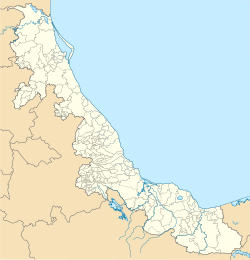Laguna Catemaco facts for kids
Quick facts for kids Laguna Catemaco |
|
|---|---|
 |
|
| Location | Catemaco Municipality, Veracruz |
| Coordinates | 18°25′N 95°05′W / 18.417°N 95.083°W |
| Type | polymictic, eutrophic |
| Primary outflows | Rio Grande de Catemaco (→San Juan River→Papaloapan River→Gulf of Mexico) |
| Basin countries | Mexico |
| Surface area | 72.54 km2 (28.01 sq mi) |
| Average depth | 7.6 m (25 ft) |
| Max. depth | 22 m (72 ft) |
| Surface elevation | 340 m (1,120 ft) |
Laguna Catemaco (which means Catemaco Lake in Spanish) is a large freshwater lake. You can find it in the middle of the Sierra de Los Tuxtlas mountains in south-central Veracruz, Mexico. It's close to the city of Catemaco.
Contents
What's in a Name?
The word laguna in Spanish often means a shallow body of water, usually salty and near the sea. But Laguna Catemaco is different! It's actually a deep, fresh water lake, not a salty lagoon.
Even though it's a lake, most people in Mexico still call it Laguna de Catemaco. Scientists, however, often use the clearer names like Lake Catemaco in English or Lago Catemaco in Spanish.
How the Lake Works
Lake Formation and Water Flow
Laguna Catemaco was created a very long time ago. Lava from the San Martin Tuxtla volcano flowed and blocked the northern part of the area. This created the lake we see today. It sits about 340 meters (1,115 feet) above sea level.
The lake is not very deep on average, about 7.6 meters (25 feet). But in some spots, like the channel between Isla Agaltepec and Catemaco city, it can be as deep as 22 meters (72 feet). The water in the lake usually moves in a clockwise direction.
Water flows out of the lake through the Rio Grande de Catemaco. This river eventually joins the Papaloapan River and then flows into the Gulf of Mexico. There are several dams on the Rio Grande that help control the lake's water level. The famous Eyipantla Falls is a 45-meter (148-foot) tall waterfall on this river, about 11 kilometers (7 miles) downstream from the lake.
Water Quality and Productivity
Laguna Catemaco is a polymictic lake. This means its water mixes completely more than twice a year. This helps keep the water well-oxygenated. However, the lake also has a lot of nutrients, which means it's eutrophic. These extra nutrients come from fertilizers used on nearby farms.
Because of all these nutrients, Laguna Catemaco is one of the most productive lakes in Mexico. It can produce up to 1,800 tons of fish and other aquatic life each year! To make sure there's enough for everyone, large fishing nets are not allowed. This helps over a thousand registered fishermen make a living.
Some common catches in the lake include the blue tilapia (a fish from Africa) and a sardine-like fish called Topote. You can also find a snail called Tegogolo.
Amazing Lake Life
Fish Species
Laguna Catemaco is home to many different kinds of fish. Scientists have found 14 species here. Some fish, like the largemouth bass and blue tilapia, were brought to the lake from other places. Others, like Vieja fenestrata and Ophisternon aenigmaticum, are found in many parts of eastern Mexico and Central America.
What's really special is that five of the fish species are endemic to the lake. This means they are found nowhere else in the world! These unique fish include the Catemaco characin, Heterandria tuxtlaensis, Catemaco molly, Catemaco livebearer, and Xiphophorus milleri. There are also other native fish like Pseudoxiphophorus bimaculatus and Xiphophorus hellerii.
Why So Many Unique Species?
The Eyipantla Falls acts like a natural barrier. It separates Laguna Catemaco from the rest of the Papaloapan River system. This means that for a very long time, possibly up to 2 million years, the lake has been isolated. This isolation allowed unique fish species to develop and thrive only in Laguna Catemaco.
Lake Environment
Size and Shape
Laguna Catemaco covers an area of about 72.54 square kilometers (28 square miles). It's shaped a bit like an oval and is almost square. Its widest points are a little over 10 kilometers (6 miles) across. The lake holds a huge amount of water: 552 million cubic meters (447,000 acre-feet). It's the eighteenth largest body of water in Mexico and the third largest lake.
Climate and Surroundings
The climate around the lake is hot and humid, with an average temperature of about 23.4 °C (75 °F). It rains a lot here, especially in Coyame, where it can get over 4,600 mm (181 inches) of rain each year. Winds from the Gulf of Mexico blow strongly across the lake all year, mostly from the northeast. Colder winds blow from November to January.
Sadly, the tropical rainforest that used to cover the entire area around the lake has been cut down a lot in recent years. This has caused more soil to wash into the lake, making its waters less clear. If this continues, the lake could eventually fill up with sediment.
Islands and Tourism
The lake's shoreline is uneven, with parts of old volcanic cones. The perimeter is about 50 kilometers (31 miles) long. It would be a great place for a 50 km sporting event, but a gap in the road at Tepeyaga peninsula makes it impossible to drive all the way around the lake.
There are several volcanic islands in the lake. Some of these islands have native and imported monkeys living on them. These monkeys are part of a research project by the University of Veracruz. Because of this, more than 70 small boats take tourists from Catemaco city across the lake to see the monkeys roaming freely. The lake has also been a filming location for movies, including Sean Connery's Medicine Man.
See also
 In Spanish: Laguna de Catemaco para niños
In Spanish: Laguna de Catemaco para niños


